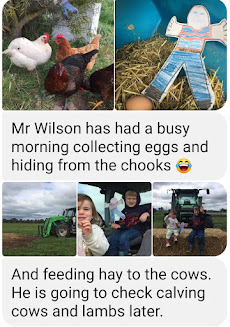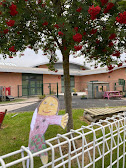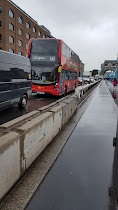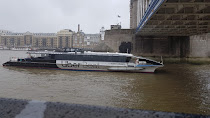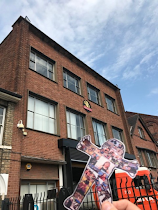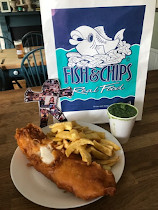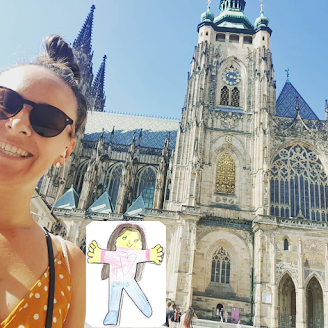Flat Miss Hartick, sent by Evan to Patrick, in Ireland
If there is anything else you would like to know about Ireland please tell us and we’ll write to you again.
Élise, Marcus & Esmée Nangle
Flat Mr Wilson has arrived in Wangaratta, Victoria, Australia.
Flat Mr Wilson was unable to travel overseas due to Covid-19, so he's enjoying being on the farm in Wangaratta, Victoria, Australia. He is having a lot of fun with Maree and her family.
Hi from Boralma in North East Victoria.
Our nearest town is Wangaratta which is located on the junctions of the King and Ovens rivers. This area is renowned for its amazing wines and gourmet foods. We are located right in the centre between the Rutherglen and Milawa wine and gourmet food regions as well as the Beechworth gold fields and a stone's throw away from Falls creek, Mt Buffalo and Hotham.
We have a very rich pioneer history including the Hume and Hovell expedition passing through and discovering the area in 1824 and Major Thomas Mitchell surveying the area in 1836. We are also only 10km from Glenrowan where the infamous shootout between police and the Kelly gang took place. The population of the Wangaratta area and surrounds is around 30,000 people.
Over the 2019/20202 summer we also experienced the horrible bushfires with lots of our friends and family coming perilously close to the fires. Thankfully they all came out relatively unscather. It was a very scary and draining time for all of us, as we were also on fire watch constantly with plans in place for our farms and livestock in case the worst should happen.
We are the Wilsons (Nathan, Maree, George and Matilda). We live on a cattle and sheep property (a bit over 1000acres) in Boralma, where we have a Black Angus Stud called Cornerstone Angus. We also breed cross bred sheep for meat and wool.
Flat Mason has been very busy the last couple of weeks helping us with calving, feeding hay, and other farm work.
Here are a few photos from his visit.
Picture one – hiding from the chooks. Mr. Wilson had a bit of fun playing hide and seek with the chickens this morning while collecting the eggs. Chickens are great for bug control around the garden as well as providing delicious and nutritious eggs for us to eat. They spend their days scratching around the orchard and eating lots of insects, grasses, seeds and anything else they find.
Picture two – collecting the eggs. Now the weather has started warming up the girls have started to lay again and are providing us with 4-8 eggs a day (usually 1 egg each a day). They will continue to do this through the warmer weather and as the weather cools down in late autumn and through winter they slow down to 2-3 eggs each a week. They get the above mentioned diet as well as ad lib (as much as they want, when they want) chook pellets and lots of household scraps including leftovers and veggies. They are particularly partial to yoghurt.
Picture 3 – feeding hay. Over winter we feed our sheep and cattle straw as a bit of roughage to go with the lush green feed they have in the paddocks. This helps to bind them up so they don’t have to eat as much grass to stay warm over the colder months as they are utilizing the nutrients in their food and don’t get the runs! We feed out the hay in a number of ways usually in the hay rings pictured so that they can eat it as they want it and don’t waste it by weeing and pooing or sleeping on it. They also get ad lib salt and nutrient lick blocks depending on the time of year. For example they are getting calving blocks at the moment as we are calving and over summer they get a dry feed block as the grass is all dry and has little nutrients in it. Other ways we feed out hay is off the back of a ute or trailer in a line so each cow can eat a little bit.
Picture 4 – driving the tractor. One of the most important pieces of equipment all farmers have is a tractor. Each type and size serve a different purpose, ours is used for feeding hay, lifting things, digging or scooping and pulling equipment such as seeders, spray units and the feed out wagon etc. They are serviced and maintained just like your family car by tractor mechanics. Our tractor has a front end loader which currently has forks on it used to pick up bales of hay to feed out. It also has a large bucket used to scoop or dig when necessary. Flat Mason is pictured here with my two children George and Matilda who are also helping with farm work today.
Picture 5 – Fodder conservation. As well as crop and pasture management we produce fodder such as hay, silage and grain to store for when the seasons get tough. In this picture you can see four different types of fodder conservation. On the left in the green plastic wrap is silage. This is usually grass or hay that is cut and baled within about 24 hours and the hay then ferments and sweetens. It is a really good source of high energy feed for cattle and sheep over summer. Next is the silo, this is used to store grains after harvest to be fed out during the year or to retain seed to be re-sown the next year. George and Matilda are sitting on a large square bale of straw. This is baled behind the header after harvest and can also contain lots of small seeds that fall out of the header. Behind the tractor to the right you can see a row of round rolls. These are made by cutting crops rather than stripping (harvesting) it and it has lots of grain and leaves in it. It is cut, raked into long rows called wind rows and when it is dry enough – usually 3-5 days depending on weather – it is baled and wrapped in net wrap. Then it is fed to livestock at any time of the year. We do lots of feed budgeting - planning - every year to try to retain as much hay, grain and silage as possible for when it gets very dry and to have some in reserve for times of drought. Seeing as we know how many cattle and sheep we have and how much feed they need at particular times of the year we are able to work out how much feed we need to try to keep over for each season. Sometimes this is not possible due to poor seasons such as drought or flood where we can not grow the required amount of feed we need. At these times we usually buy in more feed where possible.
Tomorrow Flat Mason will be very busy fencing, checking crops, and looking at new calves. We hope you have enjoyed our first email and look forward to sharing some more of Flat Mason’s farm adventures.
Flat Sienna has been out and about round my town of Inverurie, first of all we had a walk down by the River Don which I mentioned earlier, the bridge in the photo was built in 1791 and is the main route into the town from Aberdeen.
We then had a short walk down to a place called ‘The Bass’ where a castle was built in the 1100s and was lived in till 1400s.
The next photo is of Inverurie Town Hall, it is in Market Place, a busy shopping area of the town. The town hall is famous for staging the Christmas Panto for many years but sadly in 2020 due to Covid 19 has been cancelled. Just round the corner from the town hall is the railway station, we have a frequent rail service from here to Aberdeen, lots of people who work in Aberdeen take the train because the journey only takes 20 minutes.
The last photo today is of Strathburn Primary School, which is about five minutes from my house, this is the school which my children attended ( from 5 years to 12 years old) till they went to senior school.
That’s all for the moment.
Please stay safe and will speak again soon,
Ann and Flat Sienna.
Flat Paige is in England
Hi Paige,
I hope you’re having a good week, thank you for your email you looked great as a hula girl and I’m very impressed with your ninja warrior course it looks like great fun!
This week it’s all about food and drink for Flat Paige.
We has fish and chips with mushy peas which is a very British meal and yummy 😋
I took Flat Paige back into Wolverhampton and we went to visit 2 very important places (especially if you live here and like beer!)
The first place is a very old pub called The Posada which was built in 1886 and most of the building is still in its original state. It’s a Victorian Grade 2 listed building so that means it can’t be changed which is a good thing because it’s really nice. I’m sure if you ask your Grandad he will have called in at some time! England has a strong pub culture and most places have a local pub or two.
Following on from the old pub we went to visit Banks Brewery which was founded in 1875 and is supplying hundreds of pubs in the Black Country. The Black Country is the name given to Wolverhampton, Dudley, Sandwell and Walsall in the mid nineteenth century due to the smoke from the thousands of iron working foundries and forges and also the coal mining. So it seems logical with all the hard work going on that there needs to be lots of beer ready for a refreshing pint after work!
That’s all for this week, have fun and stay safe,
Sarah x
